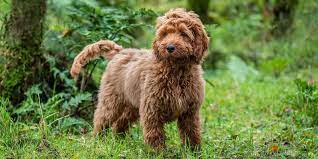Your cart is currently empty.
All You Need to Know About Bernedoodles
Dog lovers all over the world are drawn to Bernedoodles, a fascinating cross between Poodle and Bernese Mountain Dogs. In addition to its eye-catching look, this designer breed is prized for its pleasant disposition and distinctive traits that it inherited from its illustrious parent breeds.
The original purpose of breeding these dogs, which date back to the early 2000s, was to blend the intelligence and hypoallergenic coat of Poodles with the kind disposition of Bernese Mountain Dogs. The purpose of this deliberate intermarriage was to produce a low-shedding, family-friendly dog that would be appropriate for homes where allergies are an issue.
In addition to their endearing appearance, these dogs are renowned for their versatility, which allows them to fit in with a variety of home settings. When given the right care and attention, these dogs may thrive in either a large rural household or a busy urban apartment.
Bernedoodle Lifespan
A Bernedoodle lifespan normally lasts from 12 to 18 years. Numerous factors, such as heredity, stature, food, and general healthcare, affect this longevity. In comparison to their larger relatives, smaller Bernedoodle lifespans are frequently longer.
Genetic predispositions passed down from parent breeds are important in identifying possible health problems. Frequent veterinary examinations are essential for keeping an eye on health issues and taking care of them early on. Maintaining a healthy weight, exercising frequently, and making sure their diet is balanced all help these dogs live longer.
It is imperative that owners take the initiative to provide preventive healthcare, such as dental care, immunizations, and parasite control. This all-encompassing method improves the general health and well-being, which leads to a happy and longer Bernedoodle lifespan.
Grooming
For a Bernedoodle, a breed renowned for its endearing appearance and hypoallergenic coat, grooming is an essential part of their care. This thorough guide covers everything from brushing schedules to professional grooming visits when it comes to the grooming requirements of these dogs.
Coat Types and Grooming Frequency
Due to DNA from both their Poodle and Bernese Mountain Dog parents, these dogs come in a range of coat types. These coats come in a broad variety of colors and textures, from curly to wavy. Knowing the sort of coat you have will help you customize your grooming regimen.
- Wavy Coats: These coats shed less and are easier to manage. Maintaining the coat's quality and preventing matting can be achieved by brushing two to three times each week.
- Curly Coats: Dogs with a greater genetic content of Poodles are more likely to have curly coats. To avoid matting and tangling, these coats require more frequent grooming—ideally, every other day.
Brushing Techniques
Brushing is an essential part of maintaining a healthy coat and reducing shedding in this breed. Depending on the type of coat, there are different brushing techniques to use:
- Start with a Slicker Brush: This type of brush is good for reaching the undercoat and removing loose hair, so it's a good place to start.
- Transition to a Comb: A comb is a better tool for removing tangles; a finer comb works better for curly coats.
- Focus on Problem Areas: Special attention should be paid to areas that are prone to matting, like behind the ears, under the legs, and around the collar. Regular attention to these trouble spots prevents discomfort for these dogs.
Professional Grooming
Regular brushing is important, but it's also advisable to schedule professional grooming sessions, which should happen every six to eight weeks. Expert groomers have the know-how to cut and style the coat in accordance with breed requirements, making sure the Bernedoodle feels and looks its best.
- Haircut Styles: This breed can have a variety of haircuts, from a shorter "puppy cut" to a longer, more natural look, depending on the owner's preferences and the climate. A customized look is guaranteed when these preferences are discussed with the groomer.
- Cleaning and Plucking of the Ears: Like many other breeds, these dogs are prone to ear infections. To maintain healthy ears, professional groomers often remove extra hair and clean ears.
- Regular nail trimming: In order to avoid pain and possible harm, regular nail cutting is essential. Professional groomers know how to trim safely.
Maintaining Good Hygiene
Grooming extends beyond coat care, encompassing various aspects of hygiene crucial to the well-being of a Bernedoodle.
- Dental Care: Incorporating dental care into the grooming routine is vital. Brushing the dog's teeth regularly, providing dental chews, and offering appropriate toys contribute to good oral health.
- Eye Cleaning: This breed, particularly those with darker facial markings, may accumulate tear stains. Gently wiping the eyes with a damp cloth during grooming helps prevent staining and keeps the area clean.
- Anal Gland Expression: Some of these dogs may require anal gland expression, a procedure often included in professional grooming appointments. This helps prevent discomfort and potential health issues related to the anal glands.
Training Tips
Because of their intelligence and desire to please a bernedoodle is well-suited for training.
- Positive Reinforcement: To encourage desired behaviors, use a system based on rewards. Give your dog treats, verbal praise, or playtime as soon as they obey an order or behave well. They are motivated to repeat the behavior by this favorable association.
- Consistency is Key: Create a regular workout schedule. This strengthens the learning process and gives your dog a better idea of what to expect. An effective training program is built on a solid foundation of consistent orders, expectations, and incentives.
- Early Training: It is best to start training your Bernedoodle as early as possible because the puppy years are a crucial time for learning, and early socialization and command introduction will help mold their behavior.
- Socialization: During the early months of life, expose your Bernedoodle to a variety of people, places, and animals. This will help them become more self-assured, well-adjusted, and less likely to become anxious in new situations. Positive interactions during socialization contribute to a friendly and adaptable adult dog.
- Basic Commands: Prioritize instructing students in basic commands such as sit, stay, and come. These fundamental instructions improve communication between you and your dog while also ensuring improved behavior. Over time, practice makes these commands more automatic.
- Patience: Since every dog is different, training takes time. Be understanding and patient with them, and modify your training methods to fit each person's unique personality. The relationship between you and your pet is strengthened when you provide positive reinforcement and exhibit patience, as these traits foster a pleasant learning environment.
Health Considerations
- Genetic Predispositions: Like many mixed breeds, these dogs may inherit specific health issues from their parent breeds. Elbow dysplasia, hip dysplasia, and some eye disorders are common concerns. Frequent veterinary examinations can assist in identifying and resolving these problems early.
- Weight Management: Problems with weight can arise in this breed, particularly in larger breeds. Eating a balanced diet and exercising frequently are essential for avoiding obesity, joint difficulties, and other related health issues.
- Heart Health: Heart problems might affect some of these dogs. Heart-healthy eating and routine veterinary care are important for cardiovascular health in general.
- Dental Care: The state of their teeth is critical to their general health. Dental chews, the right toys, and routine teeth cleaning can all help keep your mouth healthy and prevent dental problems.
- Allergies: Although hypoallergenic, these dogs are susceptible to allergies. Effective allergy management involves keeping an eye out for symptoms of skin irritation, itching, or stomach problems and seeking veterinary advice.
Characteristics of Each Parent Breed
1. Bernese Mountain Dog Traits
- Gentle Temperament: Bernese Mountain Dogs are known for their gentle and calm nature, which often carries over to Bernedoodles.
- Loyalty: They form strong bonds with their families, making Bernedoodles affectionate and loyal companions.
- Adaptability: Bernese Mountain Dogs are adaptable to various environments, contributing to the dog’s versatility.
2. Poodle Traits
- Intelligence: Poodles are highly intelligent dogs, and this trait is often evident in these dogs, making them quick learners.
- Hypoallergenic Coats: Poodles have curly, hypoallergenic coats, a desirable trait passed on to this breed.
- Energetic: Poodles are known for their energy, and this characteristic can be seen in this breed, requiring regular exercise and mental stimulation.
Summing up
The charming blend of the perceptive Poodle and the kind Bernese Mountain Dog is embodied by Bernedoodles. Along with its attractive appearance, this designer breed has become more well-known for its adaptability, pleasant nature, and hypoallergenic traits.
If you're thinking about getting one of these dogs as a furry family member, you should start early with positive reinforcement training to help them develop excellent habits. A well-mannered and contented dog is a result of consistency, patience, and an appreciation of their distinct personalities.
Regular veterinary check-ups and a balanced lifestyle should prioritize health factors, such as hereditary predispositions, weight management, heart health, and dental treatment.
The traits that Poodles and Bernese Mountain Dogs share make for an incredibly adaptable and affectionate friend. Whether it's the calm and loyal attitude from the Bernese side or the intelligence and hypoallergenic coat from the Poodle side, these dogs bring a unique blend of attributes to improve the lives of their owners.
In providing sufficient care, attention, and understanding, this breed can thrive in varied living environments, building lifelong ties with their family. As with any breed of dog, a happy and successful relationship with these amazing four-legged pals is ensured by responsible ownership and a dedication to their welfare. If you are interested in. buying the best quality pet products do visit the product page of the leading dog products store- Ikeepet
Related Blogs
The Charm of Poodle Crossbreeds: Groodles, Spoodles, and More
Teacup Pomeranian Care Tips for Keeping Your Mini Pom Happy and Healthy
The Ultimate Guide to Rottweiler Mix Breeds
Free Delivery
From all AU orders
Support 24/7
Shop with an expert
Secure payment
100% Protected





Leave a comment